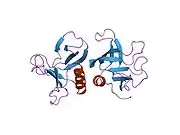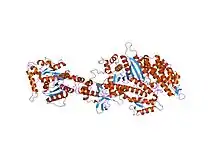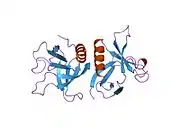Dynamin-1 is a protein that in humans is encoded by the DNM1 gene.[5][6]
Function
This gene encodes a member of the dynamin subfamily of GTP-binding proteins. The encoded protein possesses unique mechanochemical properties used to tubulate and sever membranes, and is involved in clathrin-mediated endocytosis and other vesicular trafficking processes. Actin and other cytoskeletal proteins act as binding partners for the encoded protein, which can also self-assemble leading to stimulation of GTPase activity. More than sixty highly conserved copies of the 3' region of this gene are found elsewhere in the genome, particularly on chromosomes Y and 15. Alternatively spliced transcript variants encoding different isoforms have been described.[7]
Role in disease
De novo mutations in DNM1 have been associated with a severe form of childhood epilepsy called developmental and epileptic encephalopathy. Most pathogenic variants are missense variants, and have been shown to impair synaptic vesicle endocytosis in a dominant negative manner.[8]
Interactions
DNM1 has been shown to interact with:
References
- 1 2 3 GRCh38: Ensembl release 89: ENSG00000106976 - Ensembl, May 2017
- 1 2 3 GRCm38: Ensembl release 89: ENSMUSG00000026825 - Ensembl, May 2017
- ↑ "Human PubMed Reference:". National Center for Biotechnology Information, U.S. National Library of Medicine.
- ↑ "Mouse PubMed Reference:". National Center for Biotechnology Information, U.S. National Library of Medicine.
- ↑ Obar RA, Collins CA, Hammarback JA, Shpetner HS, Vallee RB (October 1990). "Molecular cloning of the microtubule-associated mechanochemical enzyme dynamin reveals homology with a new family of GTP-binding proteins". Nature. 347 (6290): 256–61. doi:10.1038/347256a0. PMID 2144893. S2CID 4264539.
- ↑ Newman-Smith ED, Shurland DL, van der Bliek AM (July 1997). "Assignment of the dynamin-1 gene (DNM1) to human chromosome 9q34 by fluorescence in situ hybridization and somatic cell hybrid analysis". Genomics. 41 (2): 286–9. doi:10.1006/geno.1996.4596. PMID 9143509.
- ↑ "Entrez Gene: DNM1 dynamin 1".
- ↑ Dhindsa RS, Bradrick SS, Yao X, Heinzen EL, Petrovski S, Krueger BJ, et al. (June 2015). "Epileptic encephalopathy-causing mutations in DNM1 impair synaptic vesicle endocytosis". Neurology. Genetics. 1 (1): e4. doi:10.1212/01.NXG.0000464295.65736.da. PMC 4821085. PMID 27066543.
- 1 2 Micheva KD, Kay BK, McPherson PS (October 1997). "Synaptojanin forms two separate complexes in the nerve terminal. Interactions with endophilin and amphiphysin". J. Biol. Chem. 272 (43): 27239–45. doi:10.1074/jbc.272.43.27239. PMID 9341169.
- ↑ Wigge P, Köhler K, Vallis Y, Doyle CA, Owen D, Hunt SP, McMahon HT (October 1997). "Amphiphysin heterodimers: potential role in clathrin-mediated endocytosis". Mol. Biol. Cell. 8 (10): 2003–15. doi:10.1091/mbc.8.10.2003. PMC 25662. PMID 9348539.
- ↑ McMahon HT, Wigge P, Smith C (August 1997). "Clathrin interacts specifically with amphiphysin and is displaced by dynamin". FEBS Lett. 413 (2): 319–22. doi:10.1016/s0014-5793(97)00928-9. PMID 9280305. S2CID 42520828.
- ↑ Chen-Hwang MC, Chen HR, Elzinga M, Hwang YW (May 2002). "Dynamin is a minibrain kinase/dual specificity Yak1-related kinase 1A substrate". J. Biol. Chem. 277 (20): 17597–604. doi:10.1074/jbc.M111101200. PMID 11877424.
- ↑ Grabs D, Slepnev VI, Songyang Z, David C, Lynch M, Cantley LC, De Camilli P (May 1997). "The SH3 domain of amphiphysin binds the proline-rich domain of dynamin at a single site that defines a new SH3 binding consensus sequence". J. Biol. Chem. 272 (20): 13419–25. doi:10.1074/jbc.272.20.13419. PMID 9148966.
- 1 2 Kamioka Y, Fukuhara S, Sawa H, Nagashima K, Masuda M, Matsuda M, Mochizuki N (September 2004). "A novel dynamin-associating molecule, formin-binding protein 17, induces tubular membrane invaginations and participates in endocytosis". J. Biol. Chem. 279 (38): 40091–9. doi:10.1074/jbc.M404899200. PMID 15252009.
- ↑ Miki H, Miura K, Matuoka K, Nakata T, Hirokawa N, Orita S, Kaibuchi K, Takai Y, Takenawa T (February 1994). "Association of Ash/Grb-2 with dynamin through the Src homology 3 domain". J. Biol. Chem. 269 (8): 5489–92. doi:10.1016/S0021-9258(17)37484-7. PMID 8119878.
- ↑ Sastry L, Cao T, King CR (January 1997). "Multiple Grb2-protein complexes in human cancer cells". Int. J. Cancer. 70 (2): 208–13. doi:10.1002/(sici)1097-0215(19970117)70:2<208::aid-ijc12>3.0.co;2-e. PMID 9009162. S2CID 10317185.
- ↑ Wunderlich L, Faragó A, Buday L (January 1999). "Characterization of interactions of Nck with Sos and dynamin". Cell. Signal. 11 (1): 25–9. doi:10.1016/s0898-6568(98)00027-8. PMID 10206341.
- ↑ Modregger J, Ritter B, Witter B, Paulsson M, Plomann M (December 2000). "All three PACSIN isoforms bind to endocytic proteins and inhibit endocytosis". J. Cell Sci. 113 (24): 4511–21. doi:10.1242/jcs.113.24.4511. PMID 11082044.
- ↑ Modregger J, Schmidt AA, Ritter B, Huttner WB, Plomann M (February 2003). "Characterization of Endophilin B1b, a brain-specific membrane-associated lysophosphatidic acid acyl transferase with properties distinct from endophilin A1". J. Biol. Chem. 278 (6): 4160–7. doi:10.1074/jbc.M208568200. PMID 12456676.
Further reading
- Sever S (2003). "Dynamin and endocytosis". Curr. Opin. Cell Biol. 14 (4): 463–7. doi:10.1016/S0955-0674(02)00347-2. PMID 12383797.
- Wiejak J, Wyroba E (2003). "Dynamin: characteristics, mechanism of action and function". Cell. Mol. Biol. Lett. 7 (4): 1073–80. PMID 12511974.
- Orth JD, McNiven MA (2003). "Dynamin at the actin-membrane interface". Curr. Opin. Cell Biol. 15 (1): 31–9. doi:10.1016/S0955-0674(02)00010-8. PMID 12517701.
- Timm D, Salim K, Gout I, et al. (1995). "Crystal structure of the pleckstrin homology domain from dynamin". Nat. Struct. Biol. 1 (11): 782–8. doi:10.1038/nsb1194-782. PMID 7634088. S2CID 1454909.
- Downing AK, Driscoll PC, Gout I, et al. (1995). "Three-dimensional solution structure of the pleckstrin homology domain from dynamin". Curr. Biol. 4 (10): 884–91. doi:10.1016/S0960-9822(00)00197-4. PMID 7850421. S2CID 37072095.
- Ferguson KM, Lemmon MA, Schlessinger J, Sigler PB (1994). "Crystal structure at 2.2 A resolution of the pleckstrin homology domain from human dynamin". Cell. 79 (2): 199–209. doi:10.1016/0092-8674(94)90190-2. PMID 7954789. S2CID 33767806.
- van der Bliek AM, Redelmeier TE, Damke H, et al. (1993). "Mutations in human dynamin block an intermediate stage in coated vesicle formation". J. Cell Biol. 122 (3): 553–63. doi:10.1083/jcb.122.3.553. PMC 2119674. PMID 8101525.
- Miki H, Miura K, Matuoka K, et al. (1994). "Association of Ash/Grb-2 with dynamin through the Src homology 3 domain". J. Biol. Chem. 269 (8): 5489–92. doi:10.1016/S0021-9258(17)37484-7. PMID 8119878.
- Maruyama K, Sugano S (1994). "Oligo-capping: a simple method to replace the cap structure of eukaryotic mRNAs with oligoribonucleotides". Gene. 138 (1–2): 171–4. doi:10.1016/0378-1119(94)90802-8. PMID 8125298.
- Sontag JM, Fykse EM, Ushkaryov Y, et al. (1994). "Differential expression and regulation of multiple dynamins". J. Biol. Chem. 269 (6): 4547–54. doi:10.1016/S0021-9258(17)41812-6. PMID 8308025.
- Grabs D, Slepnev VI, Songyang Z, et al. (1997). "The SH3 domain of amphiphysin binds the proline-rich domain of dynamin at a single site that defines a new SH3 binding consensus sequence". J. Biol. Chem. 272 (20): 13419–25. doi:10.1074/jbc.272.20.13419. PMID 9148966.
- Ramjaun AR, Micheva KD, Bouchelet I, McPherson PS (1997). "Identification and characterization of a nerve terminal-enriched amphiphysin isoform". J. Biol. Chem. 272 (26): 16700–6. doi:10.1074/jbc.272.26.16700. PMID 9195986.
- Ringstad N, Nemoto Y, De Camilli P (1997). "The SH3p4/Sh3p8/SH3p13 protein family: binding partners for synaptojanin and dynamin via a Grb2-like Src homology 3 domain". Proc. Natl. Acad. Sci. U.S.A. 94 (16): 8569–74. doi:10.1073/pnas.94.16.8569. PMC 23017. PMID 9238017.
- McMahon HT, Wigge P, Smith C (1997). "Clathrin interacts specifically with amphiphysin and is displaced by dynamin". FEBS Lett. 413 (2): 319–22. doi:10.1016/S0014-5793(97)00928-9. PMID 9280305. S2CID 42520828.
- Wigge P, Köhler K, Vallis Y, et al. (1997). "Amphiphysin heterodimers: potential role in clathrin-mediated endocytosis". Mol. Biol. Cell. 8 (10): 2003–15. doi:10.1091/mbc.8.10.2003. PMC 25662. PMID 9348539.
- Suzuki Y, Yoshitomo-Nakagawa K, Maruyama K, et al. (1997). "Construction and characterization of a full length-enriched and a 5'-end-enriched cDNA library". Gene. 200 (1–2): 149–56. doi:10.1016/S0378-1119(97)00411-3. PMID 9373149.
- Witke W, Podtelejnikov AV, Di Nardo A, et al. (1998). "In mouse brain profilin I and profilin II associate with regulators of the endocytic pathway and actin assembly". EMBO J. 17 (4): 967–76. doi:10.1093/emboj/17.4.967. PMC 1170446. PMID 9463375.
- Slepnev VI, Ochoa GC, Butler MH, et al. (1998). "Role of phosphorylation in regulation of the assembly of endocytic coat complexes". Science. 281 (5378): 821–4. Bibcode:1998Sci...281..821S. doi:10.1126/science.281.5378.821. PMID 9694653.








